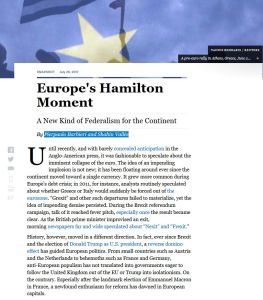Join getAbstract to access the summary!

Join getAbstract to access the summary!
Pierpaolo Barbieri and Shahin Vallée
Europe’s Hamilton Moment
A New Kind of Federalism for the Continent
Foreign Affairs, 2017
What's inside?
Times of crisis present a unique opportunity for compromise.
Recommendation
Pierpaolo Barbieri and Shahin Vallée suggest that the European Union today needs a “policy leap,” resembling the one Alexander Hamilton – the first US treasury secretary – initiated in 1790. Barbieri and Vallée draw historical lessons from the United States, Germany and Switzerland, which all in their unique ways evolved from loose federations to become strong, unified entities. getAbstract recommends this Foreign Affairs article to historians, political scientists and Europeans in general.
Summary
About the Authors
Pierpaolo Barbieri works for the Harvard Kennedy School’s Applied History Project. Shahin Vallee is a former economic adviser to French president Emmanuel Macron and EU council president Herman Van Rompuy.

















Comment on this summary